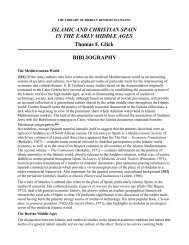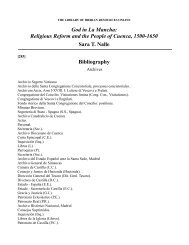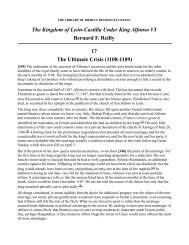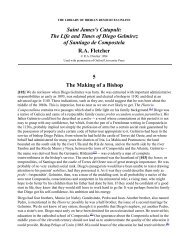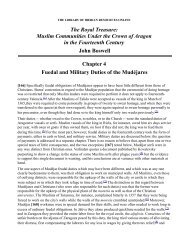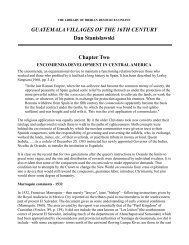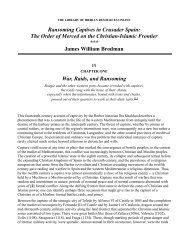The Cluniac Priories of Galicia and Portugal - The Library of Iberian ...
The Cluniac Priories of Galicia and Portugal - The Library of Iberian ...
The Cluniac Priories of Galicia and Portugal - The Library of Iberian ...
Create successful ePaper yourself
Turn your PDF publications into a flip-book with our unique Google optimized e-Paper software.
priories in a single Province <strong>of</strong> Hispania.<br />
<strong>The</strong> <strong>Cluniac</strong> Province <strong>of</strong> <strong>Galicia</strong> can thus be assigned to the years between 1172-1173 <strong>and</strong> 1218.<br />
Behind the reasons for its ab<strong>and</strong>onment -- a definitive one, as by their silence the capitular acta <strong>and</strong><br />
visitation reports make clear -- lies not only Santa María de Nájera's failure as a camerarial seat but the<br />
general deterioration <strong>of</strong> Cluny's vitality <strong>and</strong> prestige everywhere, in which her peninsular daughters<br />
shared, a decline that goes back to the 12th century <strong>and</strong> becomes increasingly acute in the 13th. <strong>The</strong><br />
capitular <strong>and</strong> visitation materials underscore repeatedly how after 1250 the six surviving Luso-Gallegan<br />
houses were inextricably enmeshed in the apparently insoluble problems having to do with recruitment<br />
<strong>of</strong> monks, incapable or dishonest priors, widespread immorality in the shrunken chapters, <strong>and</strong><br />
mismanagement or permanent loss <strong>of</strong> revenues <strong>and</strong> l<strong>and</strong>s. (181) From without, as the same sources<br />
reveal, these internal evils had their counterpart in ever more aggressive attacks by bishops upon the<br />
exemptive rights <strong>and</strong> parochial activities <strong>of</strong> the monks, <strong>and</strong> in the insatiable hunger for their l<strong>and</strong>s<br />
evinced by the Leonese-Castilian nobility. This is, however, but one chapter, which cannot properly be<br />
detached, in the painful history <strong>of</strong> the decline <strong>of</strong> all Cluny's Hispanic houses in the later Middle Ages --<br />
a large <strong>and</strong> complex subject that requires investigation on some other occasion. Meanwhile, it must<br />
suffice to have explored here the chronology <strong>and</strong> circumstances <strong>of</strong> acquisition <strong>of</strong> the <strong>Cluniac</strong><br />
dependencies <strong>of</strong> the Galaico-Portuguese zone, <strong>and</strong> to have resurrected, however tentatively, the<br />
forgotten <strong>Cluniac</strong> Province <strong>of</strong> <strong>Galicia</strong>.<br />
University <strong>of</strong> Virginia August, 1964<br />
Additional Notes<br />
[357A] <strong>The</strong> cessions to Cluny <strong>of</strong> the six Gallegan <strong>and</strong> three Portuguese monasteries which came to be<br />
included in the abbey's Province <strong>of</strong> <strong>Galicia</strong> can now be viewed in the light <strong>of</strong> further studies bearing on<br />
their motivation, political setting <strong>and</strong> protohistory. Peter Segl's substantial monograph on the <strong>Cluniac</strong><br />
connection with the Leonese-Castilian dynasty to ca. 1150 re-examines thoroughly for the entire<br />
kingdom the circumstances <strong>and</strong> implications <strong>of</strong> the transfers made from Alfonso VI to Alfonso VII. It<br />
also provides the most complete bibliography <strong>of</strong> the sources <strong>and</strong> secondary literature. (182) As regards<br />
the Luso-Gallegan houses <strong>and</strong> their donors, Segl's conclusions do not differ significantly from my own,<br />
a few minor points excepted; nor, despite the emphasis given monastic reform in his title, has he<br />
succeeded in demonstrating that this was a prominent factor in any <strong>of</strong> the nine known cases.<br />
On the priories in <strong>Galicia</strong> limited data will be found in the historical sketch by Arias <strong>of</strong> all the<br />
Benedictine communities <strong>of</strong> this province. (183) Linage Conde's massive study <strong>of</strong> Ibero-Benedictine<br />
origins does not deal directly with the priories <strong>of</strong> <strong>Galicia</strong> <strong>and</strong> <strong>Portugal</strong>, but has brief notices on their<br />
pre-<strong>Cluniac</strong> phase in the "Monasticon Hispanum" constituting the third volume. (184) Mattoso's concern<br />
with the <strong>Cluniac</strong> impulse toward Benedictinization in Minho <strong>and</strong> Beira, <strong>and</strong> the spread in northern<br />
<strong>Portugal</strong> <strong>of</strong> <strong>Cluniac</strong> customs from an assumed propagation center at Leonese Sahagún, does not pose<br />
these questions with specific reference to Rates, Santa Justa de Coimbra or Vimieiro. (185) <strong>The</strong> same is<br />
true <strong>of</strong> Feige, whose approach, basically political <strong>and</strong> oriented towards the secular church, is helpful<br />
chiefly on the general background <strong>of</strong> the three Luso-<strong>Cluniac</strong> dependencies. (186)<br />
Bernard Reilly's masterly critique <strong>of</strong> the entire diplomatic documentation for Urraca's reign makes it<br />
possible now to relate the Galaico-Portuguese cessions more accurately to their political <strong>and</strong><br />
prosopographic context. (187) At the same time, despite Reilly's focus upon the queen-empress' shifting



